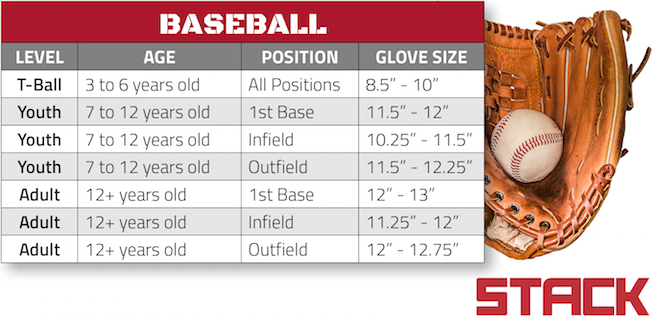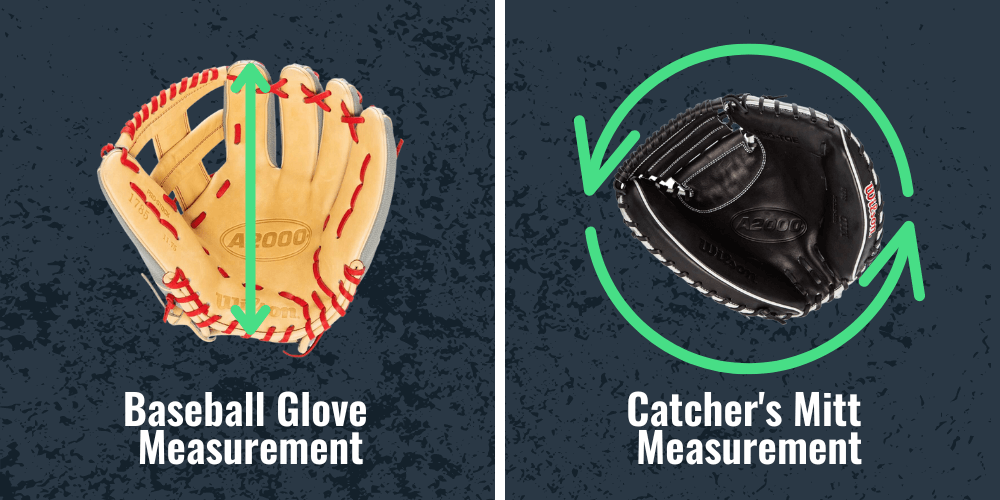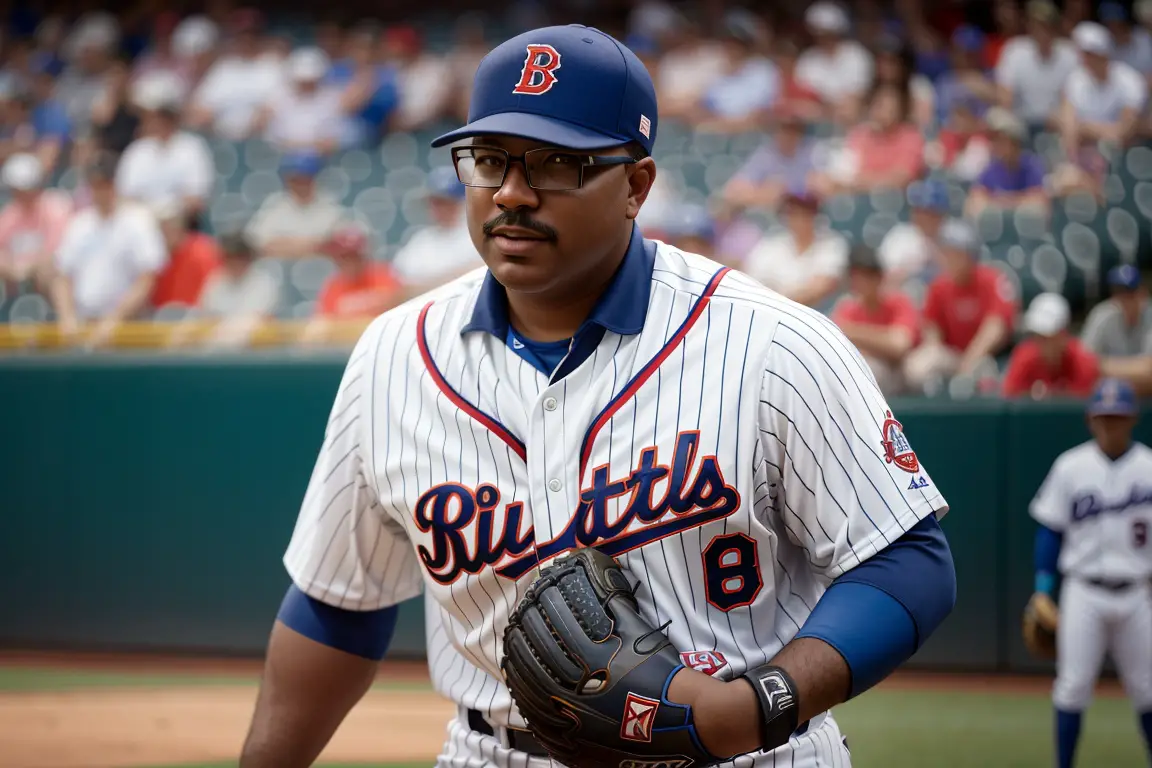Knowing the right size of a baseball glove is crucial. It impacts your performance and comfort on the field.
Choosing the perfect glove size can be confusing with various sizes available. Whether you’re a beginner or an experienced player, understanding how to find the right fit is key. The size of the glove affects how well you catch and control the ball.
Too big, and you might struggle with precision. Too small, and it could be uncomfortable or ineffective. This guide will help you determine the best glove size for your needs. By the end, you’ll know what to look for and how to measure for the perfect fit. Let’s dive in and ensure you have the right gear for your game.
Choosing The Right Glove Size
Selecting the right size for a baseball glove is crucial. A well-fitted glove enhances performance and comfort. It ensures better control and confidence on the field. Below are key considerations to help you choose the perfect glove size.
Factors To Consider
Several factors influence the ideal glove size. Age, position, and personal preference all play a role. Here are the details:
- Age: Younger players need smaller gloves. Adults need larger sizes.
- Position: Different positions require different glove sizes. Infielders use smaller gloves. Outfielders use larger gloves.
- Hand Size: Measure your hand for the best fit. Use a tape measure from the tip of your index finger to the base of your palm.
Importance Of Fit
A good fit is essential for performance. A glove that is too big or too small can hinder your game. Here’s why a proper fit matters:
- Control: A well-fitted glove offers better control. It helps in catching and fielding balls.
- Comfort: Comfort is crucial for long games. A snug glove prevents blisters and discomfort.
- Safety: A proper fit reduces the risk of injury. It keeps your hand secure during play.
Use the table below to find the recommended glove sizes based on age and position:
| Age | Position | Glove Size |
|---|---|---|
| 5-7 | All Positions | 9″ – 11″ |
| 8-10 | Infield | 10.5″ – 11.5″ |
| 8-10 | Outfield | 11.5″ – 12.5″ |
| 11-13 | Infield | 11″ – 12″ |
| 11-13 | Outfield | 12″ – 13″ |
| 14+ | Infield | 11.5″ – 12.5″ |
| 14+ | Outfield | 12.5″ – 13.5″ |
Choosing the right size can make a significant difference. It ensures better performance and enjoyment of the game.

Credit: www.stack.com
Measuring Hand Size
Choosing the right baseball glove is essential for a good game. The first step is measuring your hand size. This ensures a perfect fit and better performance. Follow these steps to measure hand length and hand width accurately.
Hand Length
To measure hand length, you need a ruler or measuring tape. Start by placing your hand flat on a table. Measure from the tip of your middle finger to the base of your palm. This gives you the hand length in inches. Write this number down for reference.
Hand Width
Next, measure the width of your hand. Open your hand wide and measure across the widest part. This is usually from the outer edge of your pinky to the outer edge of your thumb. Note this measurement too. Hand width helps in selecting a glove that fits snugly.
With these measurements, you can now find a glove that fits well. Proper fit enhances grip and control. Happy playing!
Age And Position Considerations
Selecting the right baseball glove size involves considering both age and position. These factors ensure the glove fits well and enhances performance. Each age group and position requires a specific type of glove for optimal play.
Youth Vs. Adult Gloves
Youth gloves differ from adult gloves in size and flexibility. Youth gloves are smaller, making them easier to control. They’re designed for smaller hands, promoting better grip and handling. Adult gloves are larger and more durable. They fit more mature hands and provide better protection.
Position Specific Glove Sizes
Each baseball position requires a different glove size. Infielders need smaller gloves, usually 11 to 12 inches. This size allows quick transfers and precise control. Outfielders use larger gloves, ranging from 12 to 13 inches. The larger size helps in catching fly balls. Catchers have mitts around 32.5 to 34 inches. These mitts provide better padding and catching surface.
Pitchers use gloves between 11.5 and 12.5 inches. They prefer these sizes for better grip and ball concealment. First basemen use mitts that are 12 to 13 inches. Their mitts are designed for scooping ground balls and catching throws.
Glove Size Charts
Finding the right baseball glove size is crucial. Glove size charts simplify this process. These charts offer a clear guide based on age, position, and hand size. They are easy to use and understand. Let’s dive into how to use these charts effectively.
Using A Size Chart
Start by finding a reliable glove size chart. Many sports stores and websites offer these charts. Look for charts that categorize by age and position. For example, there are specific sizes for infielders and outfielders. Measure your hand from the base of your palm to the tip of your middle finger. This measurement helps you find the right size on the chart.
Interpreting Chart Results
After finding your measurement, locate it on the chart. The chart will show a range of sizes. Choose a size within this range. For younger players, a slightly larger glove is better. It allows for growth and better hand-eye coordination. For older players, a snug fit is key for better control. Make sure to try on different gloves within the suggested size range.
Customizing For Comfort
Getting the right fit for a baseball glove involves more than just size. Ensuring comfort is key to performing well on the field. Customizing a glove can make a big difference in how it feels and functions. Here are some ways to make your glove more comfortable.
Breaking In A New Glove
A new glove is often stiff and hard to use. Breaking it in makes it more flexible. Start by using glove oil or conditioner. Apply a small amount and work it into the leather. This softens the glove, making it easier to move.
Next, play catch frequently with the glove. The repeated motion helps it form to your hand. You can also place a ball in the pocket and tie the glove shut. Leave it this way overnight to shape it better.
Adjusting Fit
Adjusting the fit of your glove ensures comfort during play. Check the glove’s laces and tighten or loosen them as needed. This helps the glove fit your hand snugly.
Some gloves come with adjustable wrist straps. Use these to find the best fit for your wrist. A glove that fits well stays in place and feels more natural.
Remember to try on the glove with your playing gear. This ensures the glove fits well with your uniform and other equipment.

Credit: www.justballgloves.com
Popular Glove Brands
Choosing the right baseball glove can make a big difference in your game. Knowing the popular glove brands helps in making an informed choice. There are many brands offering gloves with different features and sizes. Let’s explore the top brands and their sizing options.
Top Brands To Consider
When looking for a baseball glove, some brands stand out. These brands are known for their quality, durability, and comfort. Here are a few top brands to consider:
- Rawlings
- Wilson
- Mizuno
- Nike
- Easton
Each of these brands offers a range of sizes and styles. Choosing from these brands ensures you get a glove that fits well and lasts longer.
Brand-specific Sizing
Understanding the sizing from each brand can help you find the perfect fit. Here’s a quick guide on how each brand sizes their gloves:
| Brand | Typical Sizes | Special Notes |
|---|---|---|
| Rawlings | 10″ to 14″ | Popular for their Pro Preferred series. |
| Wilson | 9.5″ to 13.5″ | Best known for their A2000 series. |
| Mizuno | 10″ to 12.75″ | Offers gloves with unique Bio Soft leather. |
| Nike | 10.5″ to 12.5″ | Known for lightweight and flexible designs. |
| Easton | 10″ to 13″ | Focuses on comfort and hand protection. |
Each brand has its own range and special features. Knowing these can help in making the right choice. Always try the glove on before purchasing. A well-fitted glove improves your performance on the field.
Common Sizing Mistakes
Choosing the right size for a baseball glove is crucial. Getting the size wrong can affect the player’s performance and comfort. Below are some common sizing mistakes and how to avoid them.
Avoiding Incorrect Measurements
One frequent mistake is using the wrong tool to measure. Use a flexible tape measure for the most accurate results. Rigid rulers can lead to errors.
Another mistake is measuring only one part of the hand. Measure the full circumference around the palm and the length from the base of the palm to the tip of the middle finger. This ensures a more accurate fit.
Check the size chart from the manufacturer. Different brands may have different sizing standards. Use their specific guidelines to avoid mistakes.
Ensuring Proper Fit
Another common mistake is ignoring the player’s age and position. Youth gloves usually range from 9 to 12 inches. Adult gloves start at 12 inches.
Field position matters. Infielders usually need smaller gloves for quick ball transfer. Outfielders need larger gloves to catch fly balls. Catchers and first basemen have gloves with specific designs and sizes.
A glove too small can restrict movement. A glove too large can make it hard to control the ball. Make sure the glove fits snugly but allows free movement of the hand and fingers.
Here is a table to help understand the sizes:
| Position | Age | Recommended Size |
|---|---|---|
| Infield | 8-12 | 9-11 inches |
| Infield | 13+ | 11-12 inches |
| Outfield | 8-12 | 10-12 inches |
| Outfield | 13+ | 12-13 inches |
| Pitcher | 8-12 | 9-11 inches |
| Pitcher | 13+ | 11-12 inches |
| First Base | 8-12 | 10-11.5 inches |
| First Base | 13+ | 12-13 inches |
| Catchers | 8-12 | 29.5-32 inches |
| Catchers | 13+ | 32.5-34 inches |
Remember these tips and you will find the perfect glove size. Happy playing!
Trying Gloves In-store
Trying gloves in-store can help you find the perfect fit. You can feel the glove, test its comfort, and ensure it suits your playing style. Here’s what you need to know about trying gloves in-store.
Benefits Of In-store Fitting
Finding the right glove size is crucial for performance. In-store fitting offers several benefits:
- Immediate feedback: You can try multiple gloves and see which fits best.
- Expert advice: Store staff can provide tips and recommendations.
- Proper sizing: Measuring your hand size in-store ensures accuracy.
- Variety: You can explore different brands and styles.
Trying gloves in-store allows you to make an informed decision. This ensures you get the best glove for your needs.
What To Look For
When trying gloves, focus on these key aspects:
- Comfort: The glove should feel snug but not tight.
- Flexibility: Ensure the glove allows easy movement of fingers.
- Material: Quality leather or synthetic materials offer better durability.
- Pocket depth: The pocket should match your position’s needs.
- Wrist adjustment: Check if the wrist strap can be easily adjusted.
Try catching a ball with the glove. This helps you assess its performance. Pay attention to how the glove feels during use. A well-fitted glove can improve your game. Ensuring comfort and flexibility is key.

Credit: www.youtube.com
Frequently Asked Questions
How Do I Measure My Hand For A Baseball Glove?
To measure your hand, use a flexible tape. Measure from the tip of your index finger to the base of your palm. This length in inches is your glove size.
What Size Baseball Glove For A 10-year-old?
A 10-year-old typically needs a glove size between 11 to 12 inches. Smaller gloves fit younger kids, while older kids may need larger sizes.
Can Glove Size Affect Performance?
Yes, glove size impacts performance. A glove that’s too large or small can hinder catching and fielding. Proper fit ensures better control and comfort.
Should Infielders Use Smaller Gloves?
Infielders generally use smaller gloves, around 11 to 11. 75 inches. Smaller gloves provide quicker ball transfer and better control for infield plays.
Conclusion
Finding the right baseball glove size is crucial for comfort and performance. Measure your hand. Check glove size charts. Consider your position in the field. Try different gloves on. Comfort is key. A well-fitted glove improves your game. Follow these steps, and you’ll find the perfect glove.
Happy playing!

I’m Darrell Boyd, and I live and breathe baseball. As an ardent aficionado of the game, I have established myself as a respected figure in the baseball community through my dedicated blog and insightful contributions to the sport.
Through my blog, I strive to offer comprehensive baseball guides, tips, and tricks that cater to players of all skill levels. Additionally, I provide detailed reviews of crucial baseball products and elements, giving my readers an expert’s perspective on what truly matters in the world of baseball.
With a deep understanding of the sport’s technical intricacies and strategic nuances, I go beyond surface-level analysis, delving into the finer points that define successful gameplay. My meticulous attention to detail and unwavering commitment to excellence have made me a trusted resource for players, coaches, and fans looking to deepen their knowledge and appreciation of the game.
I am dedicated to fostering a thriving baseball culture and am passionate about sharing my wealth of insights with a growing community of fellow enthusiasts. My mission is to continue inspiring and educating others, leaving a lasting impact on the sport that resonates with millions across the globe.
